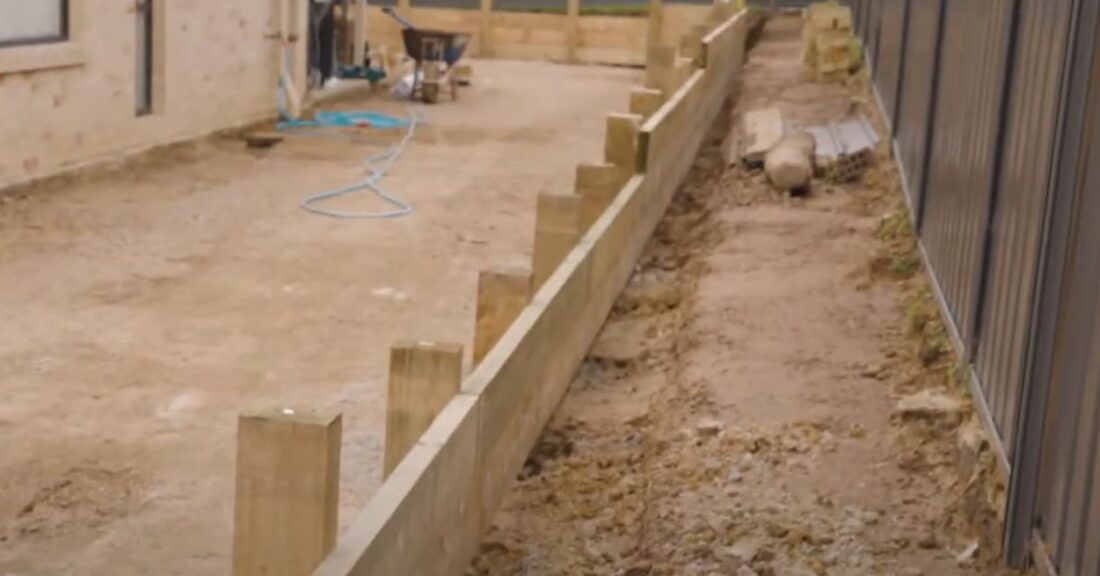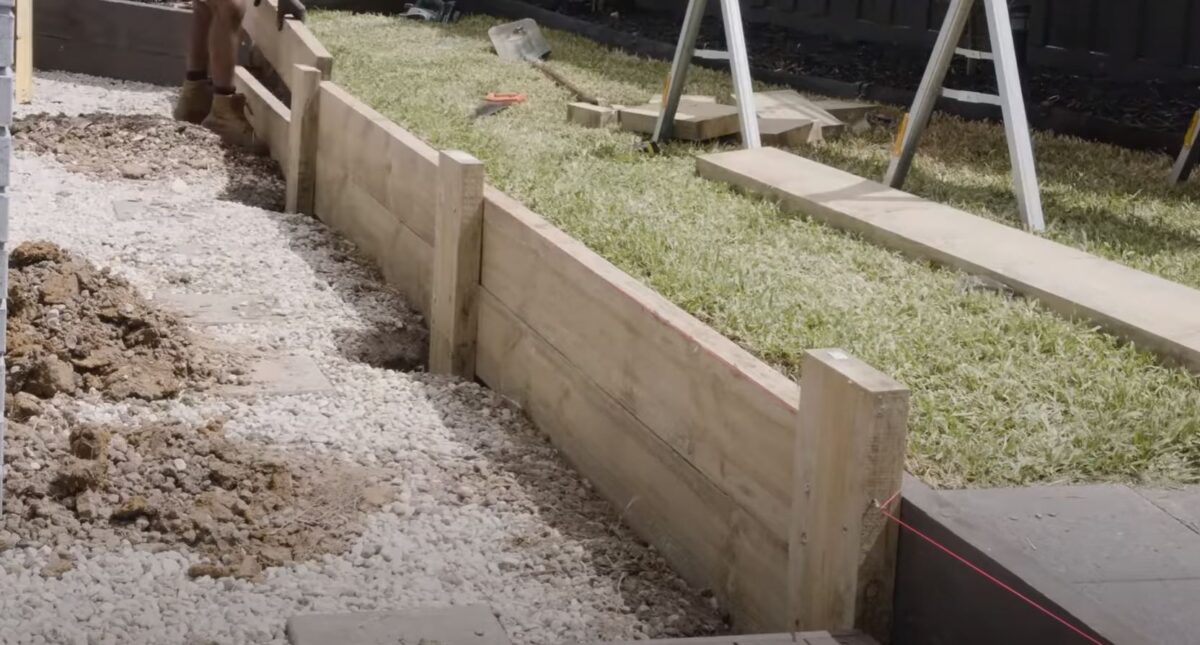Essential Drainage Strategies for Timber Retaining Walls in Auckland
In Auckland, particularly in areas like Hobsonville and Beach Haven, the construction of timber retaining walls requires careful consideration of drainage to ensure their longevity and stability. Here are some key points to consider:
- Importance of Drainage: Proper drainage is not just beneficial but essential for timber retaining walls. This is crucial for maintaining the structural integrity of the wall and extending its lifespan by preventing decay and rot.
- Moisture and Timber: Timber, being an organic material, is naturally prone to decay when exposed to prolonged moisture. Effective drainage prevents the wood from rotting and becoming a breeding ground for mould.
- Components of a Drainage System: A comprehensive drainage system for a wood retaining wall typically includes a gravel backfill, drainage pipes, and strategically placed weep holes. This setup manages and redirects moisture away from the wall, thus preventing hydrostatic pressure build-up behind it.
- Safety Considerations: Walls without effective drainage can become safety hazards, especially in Auckland’s rain-prone areas. Regular inspection of the wall, especially after heavy rainfall, is recommended to check for any signs of water damage or decay.
- Council Regulations: It’s important to be aware that the Auckland Council has guidelines regarding the construction of retaining walls, including their drainage systems. Ensuring compliance with these guidelines is crucial.
- Cost Implications: While incorporating a drainage system may increase the initial construction costs, it is a wise long-term investment. Proper drainage can save future repair costs and protects the property value.
- Expertise Matters: For residents of Auckland, engaging with professional services like Quality Fencing Auckland can be beneficial. They ensure that your retaining wall is not only aesthetically pleasing but also structurally sound with a robust drainage system.
In conclusion, when planning a timber retaining wall in Auckland, prioritizing an effective drainage system is key to its success. This approach
not only ensures the wall’s durability and safety but also aligns with local regulations and protects your investment in the long run. The use of professional retaining wall builders like Quality Fencing Auckland ensures that your retaining wall is constructed with expertise, considering both aesthetic and functional aspects. By implementing an effective drainage system, you can enhance the overall effectiveness and longevity of your timber retaining wall in Auckland’s varying climate conditions.
Timber Retaining Walls and Drainage Strategies Frequently Asked Questions
How Critical is Drainage for a Timber Retaining Wall?
Proper drainage is essential for timber retaining walls to prevent decay, rot, and structural instability caused by moisture buildup.
What Constitutes an Effective Drainage System for Timber Walls?
An effective drainage system typically includes a gravel backfill, perforated drainage pipes, and weep holes strategically placed to manage moisture.
Can Small Timber Retaining Walls Forego Drainage?
Even small retaining walls under 1 metre in height can benefit from drainage, especially in areas with heavy rainfall or impermeable soils.
What is the Best Type of Gravel for Drainage Behind Retaining Walls?
¾-inch gravel is often used for drainage behind retaining walls due to its adequate water flow and ease of installation.
How Does Groundwater Affect Timber Retaining Walls?
Groundwater can exert hydrostatic pressure on retaining walls, necessitating drainage solutions like chimney, composite, or blanket drains.
What Should Be the Depth of the Drainage Layer Behind a Timber Wall?
A minimum of 12 inches of drainage stone should be placed directly behind the wall for proper drainage.
Is Filter Fabric Necessary for Timber Retaining Wall Drainage?
Filter fabric, installed above the drainage stone, can prevent soil from clogging the drainage system and is particularly useful in clay or dark backfill soils.
How Often Should Drainage Systems in Timber Walls Be Inspected?
Inspecting the drainage system after heavy rainfalls and at least twice a year is recommended, especially in rain-prone areas.
What Are the Risks of Inadequate Drainage in Timber Retaining Walls?
Inadequate drainage can lead to wall collapse or destabilization due to water pressure and soil erosion.
Can Excess Moisture Accelerate Decay in Timber Walls?
Yes, prolonged exposure to moisture can accelerate decay and make timber susceptible to mould and rot.
Are There Specific Auckland Council Guidelines for Retaining Wall Drainage?
The Auckland Council provides guidelines for retaining wall construction, including drainage systems, which should be adhered to.
What Are the Cost Implications of Adding Drainage to Timber Walls?
While adding drainage may increase initial costs, it is a long-term investment that prevents future repair costs and safeguards property value.
How Do Weep Holes Function in Timber Retaining Walls?
Weep holes help manage moisture by allowing water to escape from behind the wall, reducing hydrostatic pressure.
What Role Does Backfill Play in Timber Wall Drainage?
Backfill, typically granular material like gravel, is crucial for drainage, allowing water to
flow through and away from the wall, effectively reducing moisture buildup and pressure against the wall.
What Materials Are Recommended for Timber Retaining Wall Drainage?
For the drainage layer, clean crushed rock like No. 57 stone is recommended. Angular gravel is preferred over rounded gravel for better water flow and stability
Does the Type of Timber Affect the Drainage Needs?
The type of timber can influence drainage needs. Hardwoods, for instance, may have different requirements than softwoods due to their density and treatment processes.
What Is the Recommended Slope for Drainage Pipes in Timber Retaining Walls?
Drainage pipes should have a positive slope of at least 2% towards the outlet to ensure efficient water flow away from the wall.
How Do Soil Conditions Impact Drainage Design for Timber Walls?
Soil conditions greatly impact drainage design. Cohesive, fine-grained soils may require more extensive drainage solutions like additional gravel or specialized pipes to manage water flow effectively.
Can Improper Drainage Lead to Safety Hazards with Timber Retaining Walls?
Yes, improper drainage can create safety hazards by compromising the wall’s stability, leading to potential collapse or leaning, especially in areas with significant rainfall.
Is There a Standard Depth for Drainage Layers Behind Timber Retaining Walls?
The depth of the drainage layer typically depends on the wall’s height and soil conditions, but a general guideline is a minimum of 12 inches of gravel or similar aggregate.
How Should Drain Pipes Be Positioned in Timber Retaining Wall Systems?
Drain pipes should be positioned at the base of the wall, sloping away from the wall to ensure effective drainage. They should be covered with filter fabric and gravel to prevent clogging.
What Precautions Should Be Taken for Timber Walls in High-Rainfall Areas like Auckland?
In high-rainfall areas, it’s crucial to ensure robust drainage systems, frequent inspections, and possibly more frequent maintenance to manage the higher water volume effectively.
Does the Height of the Timber Retaining Wall Affect Drainage Needs?
Yes, the height of the wall can affect drainage needs. Taller walls may require more comprehensive drainage solutions to handle the increased soil pressure and water volume.
How Does Water Accumulation Affect the Longevity of Timber Retaining Walls?
Water accumulation can significantly reduce the longevity of timber retaining walls by accelerating rot, decay, and structural weakening due to prolonged moisture exposure.
Are There Specific Drainage Considerations for Timber Walls Near Water Bodies?
For timber walls near water bodies, special design considerations are needed, such as higher wall rock placement and embankment protection fabric to handle water contact and fluctuations.
How Crucial Is Compacting the Backfill in Timber Wall Drainage?
Properly compacted backfill is crucial for drainage efficiency and overall wall stability. It ensures that the drainage layer functions correctly and supports the wall structure.
What Happens if a Timber Retaining Wall Lacks Adequate Drainage?
A lack of adequate drainage can lead to hydrostatic pressure buildup, causing bulging, cracking, or leaning of the wall, and potentially leading to its failure.
How Do Climate Variations in Auckland Affect Timber Wall Drainage?
Auckland’s climate variations, including periods of heavy rainfall, necessitate robust and well-maintained drainage systems to handle fluctuating moisture levels effectively and ensure wall longevity.
What Role Does the Wall’s Design Play in Drainage?
The wall’s design, including its height, length, and construction materials, plays a significant role in determining the type and extent of drainage required to manage water effectively and maintain structural integrity.


